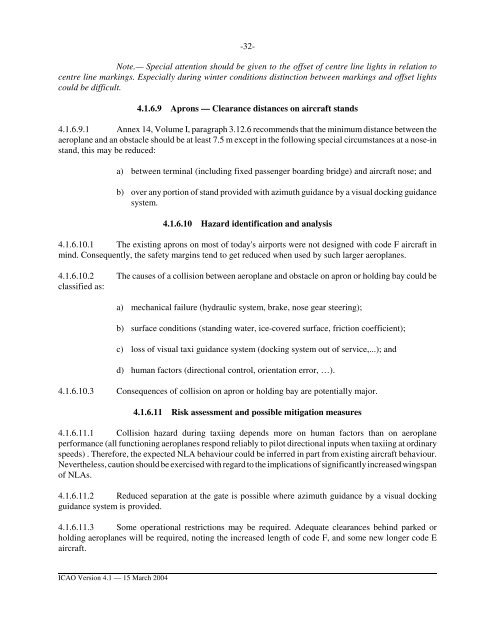Draft ICAO Circular on NLA.pdf - Airports Council International
Draft ICAO Circular on NLA.pdf - Airports Council International
Draft ICAO Circular on NLA.pdf - Airports Council International
You also want an ePaper? Increase the reach of your titles
YUMPU automatically turns print PDFs into web optimized ePapers that Google loves.
<str<strong>on</strong>g>ICAO</str<strong>on</strong>g> Versi<strong>on</strong> 4.1 — 15 March 2004<br />
-32-<br />
Note.— Special attenti<strong>on</strong> should be given to the offset of centre line lights in relati<strong>on</strong> to<br />
centre line markings. Especially during winter c<strong>on</strong>diti<strong>on</strong>s distincti<strong>on</strong> between markings and offset lights<br />
could be difficult.<br />
4.1.6.9 Apr<strong>on</strong>s — Clearance distances <strong>on</strong> aircraft stands<br />
4.1.6.9.1 Annex 14, Volume I, paragraph 3.12.6 recommends that the minimum distance between the<br />
aeroplane and an obstacle should be at least 7.5 m except in the following special circumstances at a nose-in<br />
stand, this may be reduced:<br />
a) between terminal (including fixed passenger boarding bridge) and aircraft nose; and<br />
b) over any porti<strong>on</strong> of stand provided with azimuth guidance by a visual docking guidance<br />
system.<br />
4.1.6.10 Hazard identificati<strong>on</strong> and analysis<br />
4.1.6.10.1 The existing apr<strong>on</strong>s <strong>on</strong> most of today's airports were not designed with code F aircraft in<br />
mind. C<strong>on</strong>sequently, the safety margins tend to get reduced when used by such larger aeroplanes.<br />
4.1.6.10.2 The causes of a collisi<strong>on</strong> between aeroplane and obstacle <strong>on</strong> apr<strong>on</strong> or holding bay could be<br />
classified as:<br />
a) mechanical failure (hydraulic system, brake, nose gear steering);<br />
b) surface c<strong>on</strong>diti<strong>on</strong>s (standing water, ice-covered surface, fricti<strong>on</strong> coefficient);<br />
c) loss of visual taxi guidance system (docking system out of service,...); and<br />
d) human factors (directi<strong>on</strong>al c<strong>on</strong>trol, orientati<strong>on</strong> error, …).<br />
4.1.6.10.3 C<strong>on</strong>sequences of collisi<strong>on</strong> <strong>on</strong> apr<strong>on</strong> or holding bay are potentially major.<br />
4.1.6.11 Risk assessment and possible mitigati<strong>on</strong> measures<br />
4.1.6.11.1 Collisi<strong>on</strong> hazard during taxiing depends more <strong>on</strong> human factors than <strong>on</strong> aeroplane<br />
performance (all functi<strong>on</strong>ing aeroplanes resp<strong>on</strong>d reliably to pilot directi<strong>on</strong>al inputs when taxiing at ordinary<br />
speeds) . Therefore, the expected <strong>NLA</strong> behaviour could be inferred in part from existing aircraft behaviour.<br />
Nevertheless, cauti<strong>on</strong> should be exercised with regard to the implicati<strong>on</strong>s of significantly increased wingspan<br />
of <strong>NLA</strong>s.<br />
4.1.6.11.2 Reduced separati<strong>on</strong> at the gate is possible where azimuth guidance by a visual docking<br />
guidance system is provided.<br />
4.1.6.11.3 Some operati<strong>on</strong>al restricti<strong>on</strong>s may be required. Adequate clearances behind parked or<br />
holding aeroplanes will be required, noting the increased length of code F, and some new l<strong>on</strong>ger code E<br />
aircraft.

















